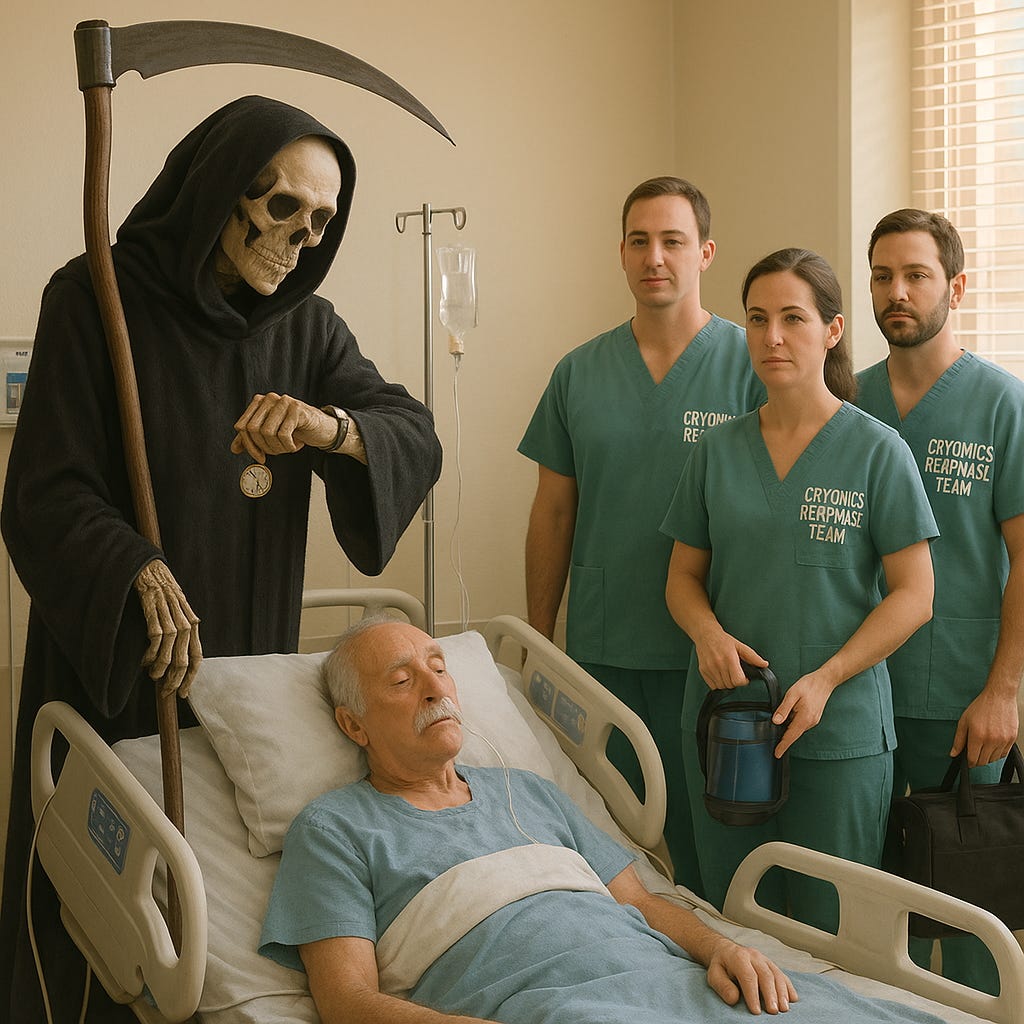Death is the Wrong Base Concept
To grow the Cryonics movement - switch over to a more accurate one.
Here’s the decades-old problem in cryonics: enormous numbers of people have heard about Cryonics in one form or another, but almost none of them take the time to learn more about it, let alone sign up.
They don’t take the time to learn that it’s actually affordable through life insurance. They don’t take the time to consider whether or not they’d value existence in the distant future. They don’t bother debating the philosophical merits of mind uploading. They don’t seem to gravitate towards curiosity about Cryonics whatsoever. It’s like they have some mental block that subtly dissuades them from pursuing the idea further.
And I have a good theory as to what that might be: we’re using death as the “base concept”, an idea that is both conceptually inaccurate for cryonics and a massive turnoff for your average Joe.
The Conceptual Slot Problem
When we encounter a new idea, we don't process it in isolation. We slot it into our existing mental architecture, finding the closest conceptual match and then modifying that pre-existing concept from there. We make sense of the unfamiliar by anchoring it to the familiar.
Consider how people understood early automobiles as "horseless carriages." The base concept was "carriage," modified by removing the horse. Not perfect, but good enough to get people oriented. Or how we explained email: "electronic mail." Start with mail, modify it to be “electronic”, and people basically get it.
When it comes to Cryonics, the industry has traditionally defaulted to death as the base concept, likely because:
Legal death is required before preservation can begin.
Legal death is required for life insurance to kick in.
Unlike average Joe, Cryonicists have a sophisticated understanding of death as a “process” rather than as a specific moment in time, so they instinctively recognize they’re not referring to an irreversible end-point.
Unlike average Joe, Cryonicists usually think of “information theoretic death” as “true death” rather than what a layman might call “death”.
But this creates an immediate problem: death, in the minds of the “average Joe” (or Jane), is definitionally irreversible. It's not just that people don't usually come back from death—it's that "coming back from death" is a category error, like a square circle or a married bachelor. For most people, saying you’ll bring someone “back from the dead” activates the religious anchor points in the brain (or maybe zombie movies, but neither of these associations are beneficial here), not the scientific ones.
So when we explain cryonics as "preserving people after death for future revival," we're asking people to modify their concept of death in a way that doesn’t work. When the average person is asked to rethink their concept in this way they’ll immediately categorize cryonics alongside the Jehovah’s witness coming to their door selling eternal salvation - and likely regard the cryonics with a similar massive dose of skepticism from the onset. This mismatch creates a massive communications and marketing challenge, unless…
A New Proposal
What if we chose a different conceptual anchor entirely? What if instead of trying to modify the "death" concept into something reversible, we started with something already understood as reversible?
What if we started with sleep?
The Dreamless Sleep
Sleep is the universal human experience of reversible unconsciousness. Sleep is a normal and natural process. Sleep already contains the core elements we need: temporary unconsciousness, devices to wake us up (eg. alarm clocks), and a universal understanding of reversibility. What would we have to do to the base concept “sleep” in order to make it work for cryonics?
We’d have to modify the concept of sleep to now mean the following:
This would be a dreamless sleep
This is a form of sleep you don’t wake up from without intervention
This is a form of sleep we don’t yet know how to wake you up from
This is a form of sleep you’ll probably be in for a good long time (decades, maybe more)
The core concept is: you’re still there but not experiencing the world. You’re definitely not “dead”, and whatever makes you you hasn’t dissolved into the void nor has it floated away into the ether.
You’re still you, you’re still there, and the intention is to wake you up, not “bring you back from the other side”.
The Reframe in Action
Consider how differently these conversations go:
Traditional framing: "After you're legally dead, we preserve your body at very low temperatures, betting that future technology can reverse the death process."
Sleep framing: "You enter a form of extremely deep cold sleep, we call it “cryosleep” and we keep you in that state until future medicine can wake you up."
We're taking sleep and adding a few modifiers, not taking death and inverting everything a normal person knows about it. The conceptual lift is an order of magnitude easier.
Some objections
"But it's not actually sleep!"
Neither was the steam locomotive a horse made of iron, but at first people called them "iron horses" because that was the best shorthand for understanding. Nobody felt betrayed when they learned these machines didn’t have internal organs and didn’t eat hay. Metaphors aren't lies; they're bridges. Once people cross the bridge to understanding, you can add nuance.
"Scientists will object!"
Scientists already object to plenty of useful simplifications. In technical contexts, we'll use technical language. If you need to describe what is actually going on you don’t say “the guy died during surgery” you say “he experienced cardiac arrest, but brain activity never ceased”, etc. In public communication, we'll use language that communicates the core concept most clearly.
"It sounds like science fiction!"
You're right! Sci-fi writers figured this out decades ago. Notice how cryo-pods never involve 'death' and 'revival'; they almost always frame it as hibernation or sleep. Writers know they'll lose the audience if they talk about “dead people” in cryopods being brought back to life.
"Legal complications!"
Yes, legally, the person is and must be “dead”. But this fact can be explained during the signup process, a part of the process we’ll never get to with most people if we insist on using this death-language in the marketing material.
“What if we really changed the culture and even insurance companies started saying this wasn’t actually death!”
That sounds like a fantastic problem to have. Yes, obviously this would mean we’d need to rethink the payment model for cryonics, but you can bet we’d all live in a better world if this was seen as a form of medicine rather than as an alternative to cremation or burial.
The Path Forward
Starting immediately, I'm adopting "cryosleep" in all my public communications about cryonics. On the podcast, at conferences, in casual conversations—cryosleep it is. Not because it's perfect, but because it's better. Not because it captures every nuance, but because it captures the right ones and translates the concept more accurately for people learning about it for the first time.
Will this transform the industry overnight? Of course not. But if even a handful of us start using terminology that actually communicates what we're trying to achieve, we might start seeing more signups and fewer objections that don’t seem like they’re the “real” objection.
I encourage you to experiment with this framing. Try explaining cryonics as a form of “sleep” requiring future medical intervention to reverse. Instead of leading with 'cryonics happens post-death' at your next cocktail party, try instead 'it's like medical hibernation we can't reverse yet' and watch to see if people lean in with more questions.
Every conceptual barrier results in otherwise smart curious people instinctively dismissing the idea, people who might otherwise sign up if they didn’t hit that wall up front.
The cryonics industry has spent decades working on the technical aspects of cryopreservation. We work on improving response times, s-mix scores, or cryopreservation solutions. But if we can't explain what we're doing in terms people instinctively understand, the technical progress goes largely to waste.
Sleep well, fellow Cryonicists!





I agree with the premises and find them very interesting. It's something to keep in mind when debriefing an introduction to cryonics to someone new.
However, I think the proposed solution doesn't suit me — though that doesn't mean it's bad. I would probably put people off more if I approached them this way. It feels somewhat dishonest; after all, we're trying to reframe the concept of death into something reversible — and not just in words. It feels like setting myself up for an unavoidable semantic debate with no good outcome. Either I concede and appear confused, or I stand firm and look like I'm in denial.
I don’t feel that the "death" framing is as off-putting as the article suggests. I rarely encounter negative reactions — people are usually intrigued, curious, even fascinated. I think some were genuinely interested; maybe a handful will eventually sign up. For most, the idea of reversible death is unfamiliar. But I believe the door has been unlocked. And we can thank science fiction for making sure that door existed in the first place, which weakens the "iron horse" argument. Back then, there weren’t many words for alien concepts. AI was once purely a sci-fi notion, and now everyone and their grandmother uses the term, even if what we have isn’t quite what science fiction promised (at least not yet).
It feels like trying to hack your way out of a problem by sidestepping into another. I don’t think I can pull it off, but I’d be really interested to see someone else succeed.
Interesting idea for reframing. For some reason cryosleep doesn’t appeal to me. Maybe we could just use the word stasis or biostasis like we started to.